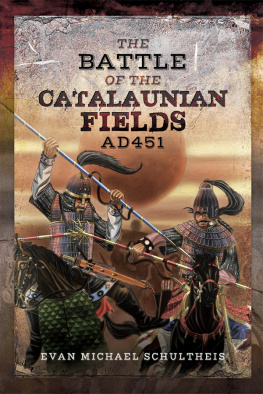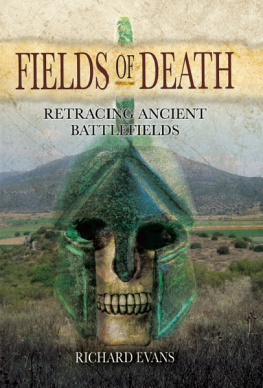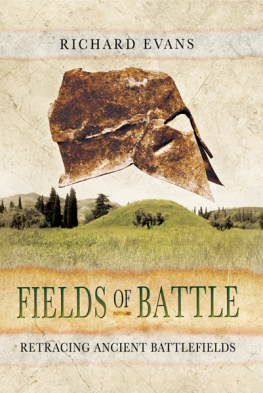Pagebreaks of the print version

The Battle of the Catalaunian Fields, AD 451
The Battle of the Catalaunian Fields, AD 451
Flavius Aetius, Attila the Hun and the Transformation of Gaul
Evan Michael Schultheis

First published in Great Britain in 2019 by
Pen & Sword Military
An imprint of
Pen & Sword Books Ltd
Yorkshire Philadelphia
Copyright Evan Michael Schultheis 2019
ISBN 978 1 52674 565 1
eISBN 978 1 52674 566 8
Mobi ISBN 978 1 52674 567 5
The right of Evan Michael Schultheis to be identified as Author of this work has been asserted by him in accordance with the Copyright, Designs and Patents Act 1988.
A CIP catalogue record for this book is
available from the British Library.
All rights reserved. No part of this book may be reproduced or transmitted in any form or by any means, electronic or mechanical including photocopying, recording or by any information storage and retrieval system, without permission from the Publisher in writing.
Pen & Sword Books Limited incorporates the imprints of Atlas, Archaeology, Aviation, Discovery, Family History, Fiction, History, Maritime, Military, Military Classics, Politics, Select, Transport, True Crime, Air World, Frontline Publishing, Leo Cooper, Remember When, Seaforth Publishing, The Praetorian Press, Wharncliffe Local History, Wharncliffe Transport, Wharncliffe True Crime and White Owl.
For a complete list of Pen & Sword titles please contact
PEN & SWORD BOOKS LIMITED
47 Church Street, Barnsley, South Yorkshire, S70 2AS, England
Email:
Website: www.pen-and-sword.co.uk
or
PEN AND SWORD BOOKS
1950 Lawrence Rd, Havertown, PA 19083, USA
Email:
Website: www.penandswordbooks.com
List of Plates
Fifth-century auxilia palatina officer
Fifth-century comitatenses infantryman
Equipment of an early fifth-century soldier
Foederatus from the North Sea in the service of Aetius
Fifth-century eastern Germanic warrior
Hunnic spatha and narrow langseax
A late Roman fulcum
Late Roman field tent
Treasure of Pouan
Sarry burial finds
Bieberweir-type imitation ridge helmet
Mundolsheim burial finds
Kispek lamellar helmet
The Theodosian land walls
Remains of the walls of Orleans
Remains of the walls of Le Mans
Remains of the walls of Sens
River Vanne at Fontvannes
Montgueux ridge, south face
Montgueux ridge, north-east face
Les Maures ridge, battlefield centre-right
Les Maures ridge, battlefield centre
Les Maures ridge, battlefield left
Maps
Central Asia in 311
The Roman World in 360
The Campaigns of 44143 and 44648
The Roman World in 450
The Campaign of 451
Battle of the Catalaunian Fields, Deployment 72
Battle of the Catalaunian Fields, Opening Stage 77
Battle of the Catalaunian Fields, Crisis 81
Battle of the Catalaunian Fields, Retreat 83
The Campaign of 452 91
The Late Fifth-Century Balkans, 45469 97
The Collapse of Gaul, 45270 101
Acknowledgements
T his work has been the culmination of more than ten years of research since I first became interested in Roman history at the age of 11 in 2006, after watching the admittedly cheesy Barbarians II series on the History Channel . It began as an attempt to submit an article to the Journal of Late Antiquity , which was rejected, but I had constructive feedback provided to me because of this attempt, which inspired me to continue in my endeavour by seeking out dozens of volumes of modern scholarship. It has since then been an on and off crusade of research, interrupted only by university coursework, which has spurred many of my side projects on the obscure fifth-century Roman Army. As a result, my knowledge of the era has dramatically transformed over the past few years: this is the culmination of that knowledge.
Without the internet, I could not have acquired most of the scholarly books and journals that were used to build this volume. Indeed, this work could be considered a result of the digitization of classics and history. I would like to thank the members of RomanArmyTalk.com for providing references, copies of primary or secondary sources, reviews and discussion which have helped me generate many of my arguments here. I would like to give special commendations to Michael Kerr and Marko Jelusic for taking their time to scan dozens of articles, and Mr Hays of the Ida Jane Dacus Library at Winthrop University, who provided many books which would have otherwise been inaccessible to me. Secondly, I would like to thank various members participating in the re-enactment community, like Robert Vermaat, Matthew Bunker, Seb Herzynia, Nadeem Ahmad and many others, who have a knowledge of the history and archaeology that more than qualifies them for the title of expert. Many of them also gave me permission to use photos of their reconstructions for this work. Thirdly, I must thank Pavel Simak for providing the fantastic cover art for this volume.
I would like to thank some of the academics who have encouraged and influenced me and this work, including my Latin teachers and professors Dr Tracy Seiler and Dr Joseph Tipton; authors who have written on the battle, including Ian Hughes, MA, and Dr Hyun Jin Kim, who constantly engaged me in lively discussion and agreed to review this work; and other authors, such as Dr Guy Halsall, Dr Roger Blockley, Dr Ralph Mathisen and Simon MacDowall, for pointing me towards books, answering my persistent questions and allowing me to use photos. It would be impossible to name all the academics, enthusiasts, and re-enactors who have uploaded their works to the internet, an ever-expanding database of source material, but general thanks I give to them. Sadly, I cannot possibly name everyone who deserves recognition; but it is on that particular note that I would also like to give special thanks to the unnamed reviewer who gave such constructive criticism of my rejected article. I literally could not have done it without you.
I would like to dedicate this work to my friend Rusty Myers, Primus Pilus of VI Ferrata Fidelis Constans , our re-enactment group. Rusty brought me into re-enactment and continued to encourage me throughout the composition of this work, and I cannot thank him enough.
Introduction
S idonius Apollinaris describes the events surrounding what has long been considered one of the most pivotal battles in late antiquity with the single phrase the barbarian world, rent by a mighty upheaval, poured the whole north into Gaul.
The Battle of the Catalaunian Fields was recounted for the first time in almost a millennium by none other than Sir Edward Gibbon. Gibbons long-outdated but comprehensive work, The History of the Decline and Fall of the Roman Empire , called the battle the last victory which was achieved in the name of the Western Roman Empire. Despite the perpetuation of the traditional nineteenth-century views, twentieth-century scholarship has greatly advanced our understanding of the battle, its context and the context in which the primary sources were written.
The commentary by J.B. Bury in the early twentieth century could be considered the first serious attempt at a discussion of the real historical importance of the Battle of the Catalaunian Fields. Bury offered what would become the traditionally accepted date of the battle, while expressing views against a macro-historical importance of the battle. He dedicates a small section of his book to the campaign of 451, arguing that the siege of Orleans just before the engagement was the real turning point in Attilas invasion, and that the Battle of the River Nedao in 454 was more instrumental in European history.










